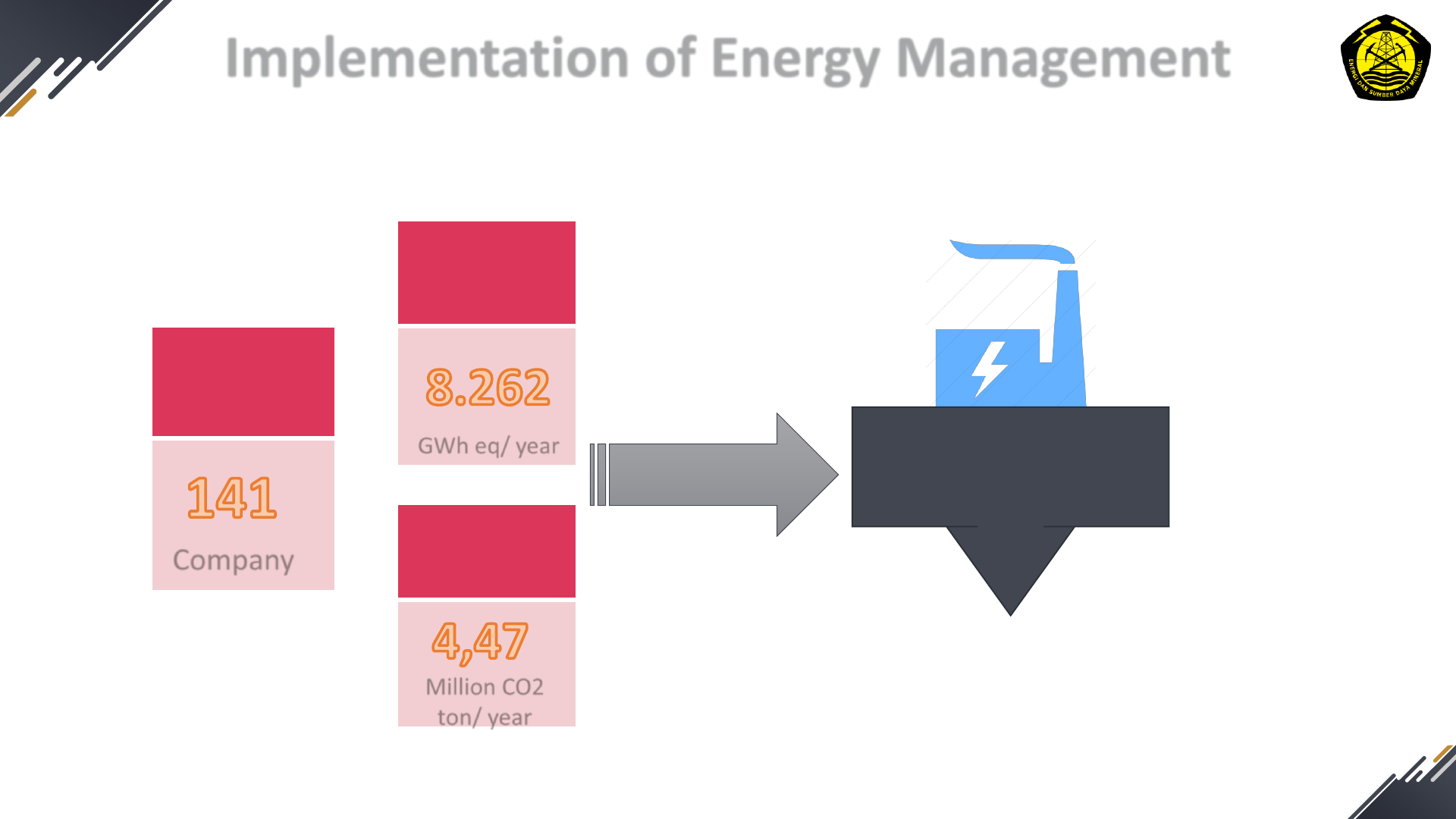
INDUSTRIAL ENERGY
EFFICIENCY POLICY IN
INDONESIA
DIRECTORATE GENERAL OF NEW RENEWABLE ENERGY & ENERGY CONSERVATION
MINISTRY OF ENERGY AND MINERAL RESOURCES

43%
16%
5%
31%
5%
Final Energy Consumption
5
Others
Household
Commercial
Industry Transport
Final Energy Mix by Sector
2006 2007 2008 2009 2010 2011 2012 2013 2014 2015 2016
Others
26 25 25 25 22 27 34 31 29 33 19
Transportastion
170 175 186 210 230 278 330 341 343 307 303
Commercial
25 26 27 28 30 33 36 38 39 41 40
Household
85 87 84 81 82 85 92 100 106 111 115
Industry
234 295 276 260 306 330 325 238 245 264 217
-
100
200
300
400
500
600
700
800
900
Million BOE
670
753
539
608
598
605
817
748
761
756
694
2006
2011
44%
11%
4%
37%
4%
2016
31%
16%
6%
44%
3%
Reference : -. Excluding Biomass
-. Other sectors including agriculture, construction and mining
Source: Handbook of Energy & Economic Statistics of Indonesia 2017 Final Edition, KESDM

Energy Saving Potential
7
INDUSTRY
Consumption 2016: 217 MBOE
Energy saving potential
10-30 %
Programs:
• Energy Audit/ IGA/ ESCO
• Energy Management/ ISO 50001
• Online reporting system
• Energy manager&auditor certification
• Increase public awareness
• Pilot Project
COMMERCIAL
Consumption 2016: 40 MBOE
Energy saving Potential
10-30 %
Programs:
• Energy Audit / IGA/ ESCO
• Pilot Project
• Energy Efficiency Standard
• Online Reporting System for
Government Building
TRANSPORT
Consumption 2016: 303 MBOE
Energy saving Potential
15-35 %
Programs:
• Mass transport (BRT/ MRT/ LRT)
• Fuel Switching (Fuel oil to Natural
Gas & Biodiesel)
• Transport Management System
HOUSEHOLD
Consumption 2016: 115 MBOE
Energy saving Potential
15-30 %
Programs :
• EE Standard (Label/ MEPS)
• Public awareness
Reference : -. Excluding Biomass
-. Other sectors including agriculture, construction and mining
Source: Handbook of Energy & Economic Statistics of Indonesia 2017 Final Edition, KESDM

ENERGY CONSERVATION
IN INDUSTRIAL SECTOR
26

Classification of Industrial Sectors
The division of industries by subsector refers to the Indonesian Standard Classification of
Business Fields (KBLI) 2009
No Subsektor Industri Keterangan
1
Food Industry
Primary Industry
2
Pharmaceutical Industry, Cosmetics, and Medical Devices
3
Textile, Leather, Footwear, and Multifarious Industries
4
Transportation Equipment Industry
5
Electronics and Telematics / ICT Industry
6
Power Plant Industry
7
Capital
Goods, Components, Auxiliary and Services Industry Supporting Industry
8
Upstream Agro Industry
Upstream Industry
9
Basic Metal and Non Metallic Quarrying Industry
10
Basic Chemical Industry Based on Oil, Gas and Coal

Energy Conservation on the Utilization Side
(Government Regulation No 70 Year 2009 Article 12)
29
1. Appoint an energy manager;
2. Preparing energy conservation programs;
3. Conducting periodic energy audits;
4. Implementing the recommendations of the energy audit results;
5. Report on the implementation of energy conservation to the Government
Mandatory for energy users that consume more than 6,000 TOE * per year to apply
energy management
The number of energy users is not too much, but the total energy consumption reaches about
60% of energy use in the industrial sector.
6000 TOE equivalent to 251,400 giga joules (GJ) or 69,780 mega watt hour (MWh).
*)

MEMR Regulation Number 14 Year 2014
30
ENERGY MANAGEMENT
Conducting Energy
Audit Results
Appoints Energy
Manager
Must establish an
energy management
team
The energy
management team is
headed by energy
managers
The Energy Manager
must have a
competency certificate
Recommended
Without Cost applied in
less than 1 year
Low Investment
Recommendations
applied in less than 2
years
Medium Investment
Recommendations and
High Investment
Recommendations
applied in less than 5
years
Performed
periodically at least 1
(one) time in 3 (three)
years.
Conducted by an
internal energy
auditor and / or an
accredited institution.
The auditor must
have a competency
certificate
Conducting an
Energy Audit
Reporting on the
Implementation of
Energy Management
Annual report submitted
to MEMR c.q. Director
General of NREEC,
governor, and regent /
mayor in accordance with
their authority
Report submitted in
January s.d. March 31 of
the following year
Reporting for the first
time delivered in January
2013

Trend of Energy Management Reporting
0
20
40
60
80
100
120
140
160
2012 2013 2014 2015 2016 2017
Kategori Hijau
0 3 10 21 27 41
Kategori Kuning
2 12 13 66 85 100
i. Green category: The Company has exercised all points contained in Article 12 Government Regulation 70/2009
ii. The yellow category: The Company has exercised some of the points contained in Article 12 Government Regulation 70/2009

Implementation of Energy Management
32
Savings gained
GWh eq/ year
Companies
reporting
Company
Equal to contstruct new
power plant
1.028 MW eq*
*power plant operational hour:
8040 hours per year
Decrease in
Green House Gas
Emissions
Million CO2
ton/ year
Year 2017 (POME)

Role of Industry Supports the Energy Conservation Program
34
Inovation:
• Increasing the capacity of human
resources in the face of rapid
dynamics
• Adoption of clean energy technology
• Optimization of industrial systems
• Process efficiency in industry
Applying Energy Management :
• High level Management Commitment for
energy efficient
• Establish a reliable energy management
system
• Continuous improvement through a good
management cycle(Plan – DO – Check - Act)
Disemination dan Colaboration:
• Online energy management reporting to the
Government to build industrial benchmarking
system
• Share success stories to inspire others
• Seeing is believing, mutual comparative study
• Collaboration builds mutual competence
Being The Best
Participated in:
• Competition in Company / Association
Group environment
• National Energy Efficiency Award / Subroto
Award (National level)
• Asean Energy Award (among ASEAN
countries)
• The Energy Management Leadership Awards
(among members of Clean Energy
Ministerial / CEM)

DIREKTORAT KONSERVASI ENERGI
KEMENTERIAN ENERGI DAN SUMBER DAYA MINERAL
ENERGY
CONSERVATION
IS
THE FOUNDATION
OF
ENERGY
INDEPENDENCE
“
“
HANK
OU
T
Y
www.ebtke.esdm.go.id
